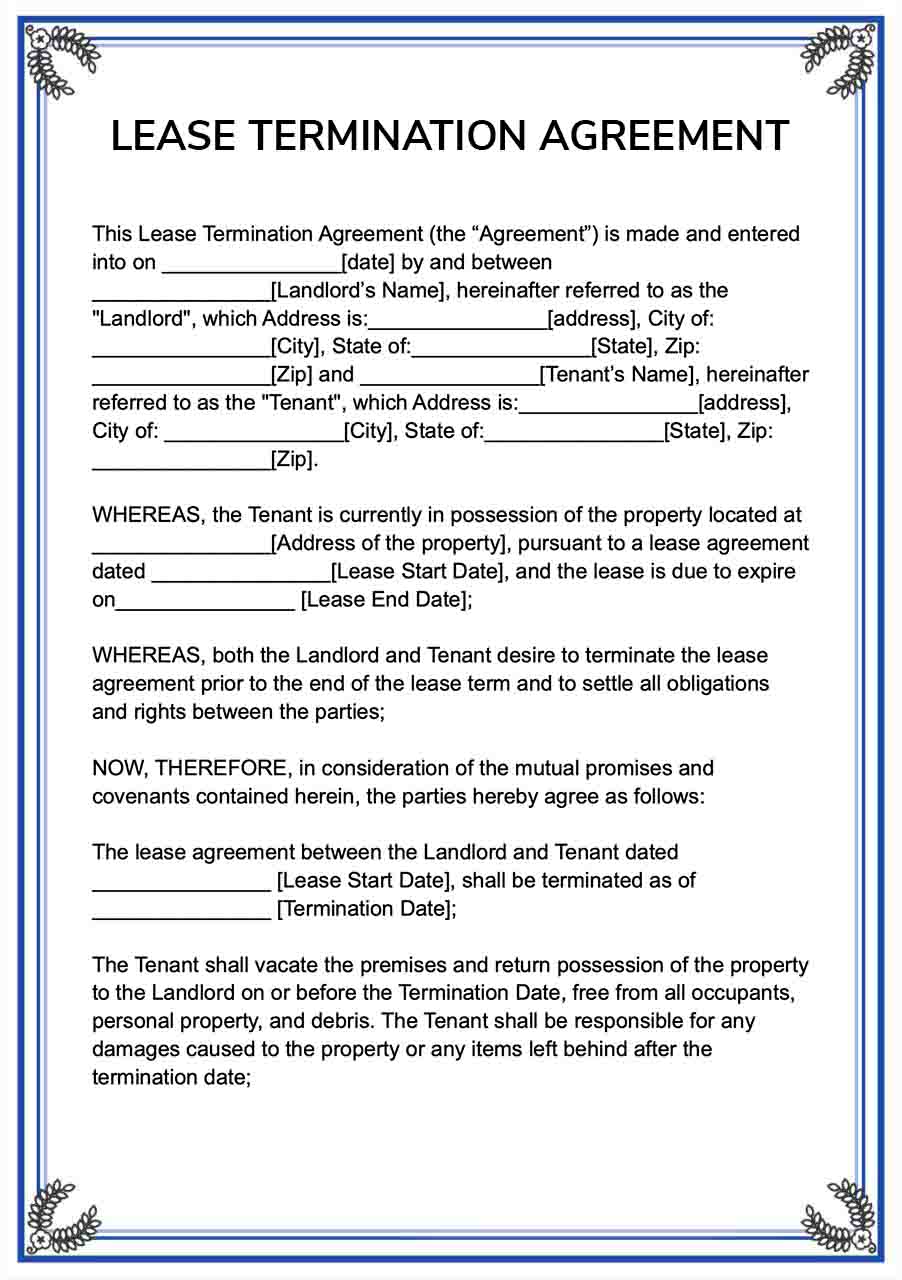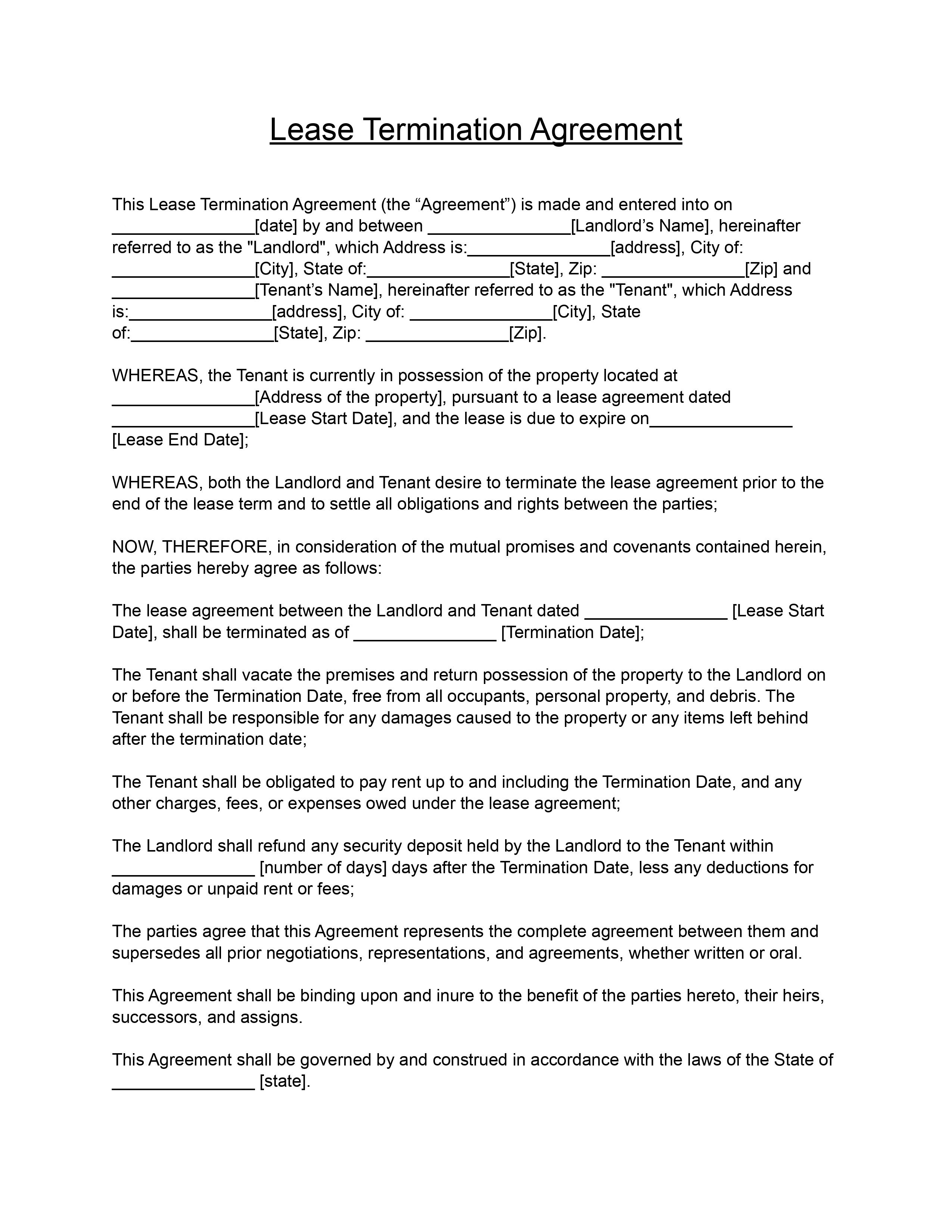Generate Lease Termination Agreement
A Lease Termination Agreement outlines the terms for ending a lease before the agreed-upon end date.
Last Updated April 2023
Alternative names:
Early Termination of Lease Agreement Rental Termination Agreement Mutual Termination Agreement Lease Cancellation AgreementWhat is a Lease Termination Agreement?
A lease termination agreement is a legal contract between a landlord and tenant that outlines the terms and conditions for ending a lease agreement before its natural expiration date. The agreement typically includes provisions for the early termination of the lease, the amount of notice required before vacating the property, any penalties or fees associated with early termination, and the return of any security deposits.
The lease termination agreement serves as a binding contract that sets out the terms under which the lease will be terminated and helps to ensure that both parties understand their obligations and rights. It may also include provisions for the disposition of any personal property left behind by the tenant and the condition in which the property is to be left upon vacating. Both the landlord and tenant must sign the lease termination agreement for it to be valid.
What is the purpose of a Lease Termination Agreement?
The purpose of a lease termination agreement is to outline the terms and conditions under which a lease agreement between a landlord and a tenant will be terminated before its natural expiration date. The agreement is designed to ensure that both parties understand their obligations and rights in the termination process, and it serves as a legal contract that protects the interests of both the landlord and tenant. A lease termination agreement typically includes provisions for the early termination of the lease, the amount of notice required before vacating the property, any penalties or fees associated with early termination, and the return of any security deposits. By having a lease termination agreement, both parties can avoid misunderstandings, disputes, and legal issues that may arise when terminating a lease without a written agreement.
What should include my Lease Termination Agreement?
A lease termination agreement should include the following information:
-
Identification of the parties involved: The agreement should identify the landlord and tenant by name and address.
-
Date of the agreement: The agreement should include the date when the lease termination agreement is being signed.
-
Property details: The agreement should include details about the property being leased, such as its address, unit number, and any other relevant details.
-
Reason for termination: The agreement should state the reason for the early termination of the lease, such as the expiration of the lease term, a breach of the lease agreement by one of the parties, or a mutual agreement between the parties.
-
Notice period: The agreement should specify the amount of notice required before the tenant vacates the property. This is usually 30 to 60 days, but it may vary depending on the terms of the lease agreement and local laws.
-
Penalties or fees: The agreement should state whether the tenant is required to pay any penalties or fees for early termination of the lease, and if so, the amount of these penalties or fees.
-
Return of security deposit: The agreement should specify when the security deposit will be returned to the tenant and under what conditions.
-
Condition of the property: The agreement should state the condition in which the tenant is required to leave the property upon vacating and any repairs or cleaning required.
-
Signature: The lease termination agreement should be signed and dated by both the landlord and tenant to indicate their agreement to the terms and conditions stated in the document.
It is recommended to consult with a legal professional to ensure that the lease termination agreement meets all legal requirements and addresses the specific circumstances of your situation.
Who needs a Lease Termination Agreement?
Both landlords and tenants may need a lease termination agreement.
A landlord may need a lease termination agreement if they need to terminate a lease early due to a breach of the lease agreement by the tenant, the tenant's failure to pay rent or other charges, or if they need to repossess the property for their own use. A landlord may also need a lease termination agreement if they and the tenant mutually agree to terminate the lease early.
A tenant may need a lease termination agreement if they need to terminate their lease early due to job relocation, financial hardship, or other personal reasons. A tenant may also need a lease termination agreement if they and the landlord mutually agree to terminate the lease early.
In both cases, a lease termination agreement can help to ensure that both parties understand their obligations and rights in the termination process and can help to avoid misunderstandings and disputes that may arise when terminating a lease without a written agreement. It is recommended to consult with a legal professional to ensure that the lease termination agreement meets all legal requirements and addresses the specific circumstances of the situation.
Frequently Asked Questions
The notice period required for terminating a lease varies depending on the terms of the lease agreement and the local laws and regulations. In many cases, the lease agreement itself will specify the required notice period for terminating the lease early. However, if the lease agreement does not specify a notice period, local laws and regulations may provide guidelines for the minimum notice period required.
In general, the notice period required for terminating a lease is typically between 30 to 60 days, although it may be longer in some cases. The notice period gives the landlord sufficient time to find a new tenant or make any necessary arrangements before the current tenant vacates the property.
It is important for both the landlord and tenant to comply with the notice period requirements as failing to do so may result in legal and financial consequences. Additionally, some lease agreements may include penalties or fees for early termination, which should also be considered when deciding to terminate a lease early.
Yes, a lease termination agreement can be negotiated between the landlord and the tenant. Both parties may have their own requirements and concerns related to the early termination of the lease, and a negotiation can help to address these concerns and reach an agreement that is mutually acceptable.
Some of the terms that can be negotiated in a lease termination agreement include the amount of notice required before terminating the lease, any penalties or fees associated with early termination, the return of security deposits, and the condition in which the property must be left upon vacating.
Negotiating a lease termination agreement can help to avoid misunderstandings and disputes that can arise when terminating a lease without a written agreement. It is important to ensure that the agreement is legally valid and meets the requirements of local laws and regulations. It is recommended to seek the advice of a legal professional to ensure that the negotiated agreement is fair and enforceable.
A lease can be terminated without a lease termination agreement, but it is not recommended.
If a lease is terminated without a written agreement, it can lead to misunderstandings and disputes between the landlord and tenant. Without a written agreement, it can be difficult to prove the terms and conditions of the termination, including the notice period, any penalties or fees, and the condition in which the property must be left upon vacating.
In some cases, a lease agreement may include provisions for termination without a written agreement, such as if the tenant abandons the property or if the landlord needs to repossess the property due to non-payment of rent or other charges. However, it is still recommended to have a written agreement to ensure that both parties understand the terms and conditions of the termination.
Having a lease termination agreement can help to ensure that the termination process is clear and transparent, and it can help to avoid misunderstandings and disputes between the landlord and tenant. It is recommended to consult with a legal professional to ensure that the lease termination agreement meets all legal requirements and addresses the specific circumstances of the situation.
In most cases, a lease cannot be terminated without penalty if there is no provision in the lease agreement for an early termination without penalty.
If a tenant terminates the lease early without the landlord's agreement or without a valid reason specified in the lease agreement, the landlord may be entitled to seek compensation for any losses incurred as a result of the early termination, such as lost rent or advertising expenses to find a new tenant.
However, in some situations, it may be possible to terminate a lease without penalty. For example, if both the landlord and tenant mutually agree to terminate the lease early, they may be able to negotiate the terms of the termination, including whether there will be any penalties or fees.
Additionally, some lease agreements may include provisions for early termination without penalty, such as if the tenant is required to relocate for work or if the landlord breaches the lease agreement.
It is important for both the landlord and tenant to review the terms of the lease agreement and any applicable laws and regulations to determine if it is possible to terminate the lease without penalty. If both parties agree to an early termination, it is recommended to have a written agreement that specifies the terms and conditions of the termination, including any penalties or fees.
Both the landlord and the tenant can terminate a lease, depending on the circumstances.
The landlord can terminate a lease if the tenant violates the terms of the lease agreement, such as failing to pay rent, damaging the property, or engaging in illegal activities on the premises. The landlord can also terminate a lease if they need to repossess the property for their own use or if they need to make significant repairs or renovations that require the property to be vacated.
The tenant can terminate a lease if they need to move out before the end of the lease term, typically due to personal or work-related reasons. However, the tenant may be required to provide a certain amount of notice and may be subject to penalties or fees for early termination, depending on the terms of the lease agreement and local laws.
In some cases, a lease may include provisions for termination without cause, such as if the lease has reached its expiration date. It is important for both the landlord and tenant to review the terms of the lease agreement and any applicable laws and regulations to determine their rights and obligations in terminating the lease.


